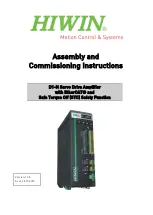
T-44/48 Series Operation Manual
19
T-44/48 Series | rev.
firm. 1.258 and above
Loudspeaker Connectors
The amplifier NL4 Speakon
TM
outputs. Connect the loudspeaker to the 1+ and 1- terminals.
CH1 also carries the (duplicated) loudspeaker output for channel 2 on terminals 2+ and 2-.
Similarly, CH3 carries the loudspeaker output for channel 4 on terminals 2+ and 2-. For Bridged
mode, use terminals 1+ and 2+ of either CH1 or CH3.
Audio Input Connectors
All audio connections are fully balanced and wired: pin-1 to ground (as required by the
AES48 standard), pin-2 hot & pin-3 cold
AES3 Audio Input connectors
For inputting Digital Audio signals. The Input is fully balanced and wired: pin-1 to ground,
pin-2 data+ & pin-3 data. The Link connector allows a buffered AES3 signal to be passed on to
another device.
Networked Audio Port
The Tecnare T-44/48 Series Amplifiers has the option for networked audio ports; if none are
required a blanking plate will be fitted. There are several options for networked audio including
Dante™
and
AVB™
. For a full list please consult
http://www.tecnare.com
or your vendor.
Ethernet Communications Port
Tecnare T-44/48 Series Amplifiers may be controlled entirely from another controller,
typically a Personal Computer, running an application that is compliant with the ObCom
standard such as System Engineer. Connection will normally be made to the controller via this
Ethernet port connector with shielded Cat-5e cables. This port is also used for updating the
firmware in the unit.
Auxiliary Port
The auxiliary port may be configured to recall snapshots or apply muting.
Relay output
This isolated relay output may be used to indicate abnormal conditions to external
monitoring apparatus. See
Fault Relay
Power Inlet
The unit should be connected to a suitable mains electricity supply using an earthed
PowerCON
®
32A (NAC3FC-HC) connection power lead. The device has a switch mode power
supply that is capable of operating with a nominal mains voltage of 100V to 230V, 50/60Hz
without re-configuration.
NOTE
: The device must be earthed to a suitable power earth; failure to do so may affect
performance and/or operation and will invalidate warranty and could be potentially hazardous.















































